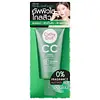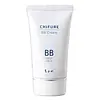What's inside
What's inside
 Key Ingredients
Key Ingredients

 Benefits
Benefits

 Concerns
Concerns

 Ingredients Side-by-side
Ingredients Side-by-side

Water
Skin ConditioningCyclopentasiloxane
EmollientGlycerin
HumectantPropylene Glycol
HumectantCaprylyl Methicone
Skin ConditioningTitanium Dioxide
Cosmetic ColorantCyclohexasiloxane
EmollientBetaine
HumectantCetyl PEG/PPG-10/1 Dimethicone
EmulsifyingMagnesium Sulfate
Dimethicone Crosspolymer
Emulsion StabilisingVp/Hexadecene Copolymer
Butylene Glycol
HumectantHydroxyacetophenone
Antioxidant1,2-Hexanediol
Skin ConditioningHydrolyzed Collagen
EmollientNiacinamide
SmoothingSodium Hyaluronate
HumectantRosa Rugosa Flower Oil
MaskingSalicylic Acid
MaskingHamamelis Virginiana Bark/Leaf Extract
AstringentBellis Perennis Flower Extract
Skin ConditioningCamellia Sinensis Leaf Extract
AntimicrobialCentella Asiatica Extract
CleansingCeramide AP
Skin ConditioningCeramide EOP
Skin ConditioningCeramide NP
Skin ConditioningChamomilla Recutita Flower Extract
MaskingGluconolactone
Skin ConditioningGlycyrrhiza Glabra Root Extract
BleachingPolygonum Cuspidatum Root Extract
AntioxidantRosmarinus Officinalis Leaf Extract
AntimicrobialScutellaria Baicalensis Root Extract
AstringentZinc PCA
HumectantCI 77492
Cosmetic ColorantCI 77491
Cosmetic ColorantCI 77499
Cosmetic ColorantWater, Cyclopentasiloxane, Glycerin, Propylene Glycol, Caprylyl Methicone, Titanium Dioxide, Cyclohexasiloxane, Betaine, Cetyl PEG/PPG-10/1 Dimethicone, Magnesium Sulfate, Dimethicone Crosspolymer, Vp/Hexadecene Copolymer, Butylene Glycol, Hydroxyacetophenone, 1,2-Hexanediol, Hydrolyzed Collagen, Niacinamide, Sodium Hyaluronate, Rosa Rugosa Flower Oil, Salicylic Acid, Hamamelis Virginiana Bark/Leaf Extract, Bellis Perennis Flower Extract, Camellia Sinensis Leaf Extract, Centella Asiatica Extract, Ceramide AP, Ceramide EOP, Ceramide NP, Chamomilla Recutita Flower Extract, Gluconolactone, Glycyrrhiza Glabra Root Extract, Polygonum Cuspidatum Root Extract, Rosmarinus Officinalis Leaf Extract, Scutellaria Baicalensis Root Extract, Zinc PCA, CI 77492, CI 77491, CI 77499
Water
Skin ConditioningCyclopentasiloxane
EmollientButylene Glycol
HumectantTriethylhexanoin
MaskingDimethicone
EmollientNeopentyl Glycol Dicaprate
EmollientZinc Oxide
Cosmetic ColorantPEG-9 Dimethicone
Skin ConditioningPEG-9 Polydimethylsiloxyethyl Dimethicone
EmulsifyingNylon-12
Disteardimonium Hectorite
StabilisingDimethicone/PEG-10/15 Crosspolymer
Aluminum Hydroxide
EmollientAcrylates/Dimethicone Copolymer
Skin ConditioningHydrogen Dimethicone
Dimethicone/Vinyl Dimethicone Crosspolymer
Skin ConditioningPolyglyceryl-3 Polydimethylsiloxyethyl Dimethicone
Skin ConditioningSilica
AbrasiveSodium Citrate
BufferingMethylparaben
PreservativeHydrogen Dimethicone/Octyl Silsesquioxane Copolymer
Tocopherol
AntioxidantDipotassium Glycyrrhizate
HumectantDisodium Stearoyl Glutamate
CleansingPropylparaben
PreservativeTrehalose
HumectantDipropylene Glycol
HumectantSodium Hyaluronate
HumectantPEG-10 Dimethicone
Skin ConditioningSodium Acetylated Hyaluronate
HumectantTriethoxycaprylylsilane
Scutellaria Baicalensis Root Extract
AstringentTitanium Dioxide
Cosmetic ColorantIron Oxides
Water, Cyclopentasiloxane, Butylene Glycol, Triethylhexanoin, Dimethicone, Neopentyl Glycol Dicaprate, Zinc Oxide, PEG-9 Dimethicone, PEG-9 Polydimethylsiloxyethyl Dimethicone, Nylon-12, Disteardimonium Hectorite, Dimethicone/PEG-10/15 Crosspolymer, Aluminum Hydroxide, Acrylates/Dimethicone Copolymer, Hydrogen Dimethicone, Dimethicone/Vinyl Dimethicone Crosspolymer, Polyglyceryl-3 Polydimethylsiloxyethyl Dimethicone, Silica, Sodium Citrate, Methylparaben, Hydrogen Dimethicone/Octyl Silsesquioxane Copolymer, Tocopherol, Dipotassium Glycyrrhizate, Disodium Stearoyl Glutamate, Propylparaben, Trehalose, Dipropylene Glycol, Sodium Hyaluronate, PEG-10 Dimethicone, Sodium Acetylated Hyaluronate, Triethoxycaprylylsilane, Scutellaria Baicalensis Root Extract, Titanium Dioxide, Iron Oxides
Ingredients Explained
These ingredients are found in both products.
Ingredients higher up in an ingredient list are typically present in a larger amount.
Butylene Glycol (or BG) is used within cosmetic products for a few different reasons:
Overall, Butylene Glycol is a safe and well-rounded ingredient that works well with other ingredients.
Though this ingredient works well with most skin types, some people with sensitive skin may experience a reaction such as allergic rashes, closed comedones, or itchiness.
Learn more about Butylene GlycolCyclopentasiloxane, or D5, is a silicone used to improve texture of products and trap moisture.
D5 is considered lightweight and volatile. Volatile means it evaporates quickly after application. Once evaporated, D5 leaves a thin barrier that helps keep skin hydrated.
It is also an emollient. Emollients help soften the skin and prevent water loss. Silicones create a silky texture in products. D5 helps other ingredients become more spreadable.
Studies show D5 is safe to use in skincare products. We recommend speaking with a skincare professional if you have concerns.
Learn more about CyclopentasiloxaneScutellaria Baicalensis Root Extract comes from the Baikal skullcap or Chinese skullcap plant. This plant is native to Northeast Asia and can be found in China, Mongolia, Korea, and Siberia.
In cosmetics, Scutellaria Baicalensis Root Extract provides antioxidant and anti-inflammatory benefits. This is due to the flavonoid composition of Scutellaria Baicalensis Root Extract.
In Chinese traditional folk medicine, Scutellaria Baicalensis Root Extract is used to help treat lung issues and hypertension.
Learn more about Scutellaria Baicalensis Root ExtractSodium Hyaluronate is hyaluronic acid's salt form. It is commonly derived from the sodium salt of hyaluronic acid.
Like hyaluronic acid, it is great at holding water and acts as a humectant. This makes it a great skin hydrating ingredient.
Sodium Hyaluronate is naturally occurring in our bodies and is mostly found in eye fluid and joints.
These are some other common types of Hyaluronic Acid:
Learn more about Sodium HyaluronateTitanium dioxide is a mineral UV filter widely used in sunscreens and cosmetics.
It is one of only two UV filters officially classified as “mineral” by regulatory agencies, the other being zinc oxide.
Titanium dioxide provides broad-spectrum protection mostly in the UVB and UVAII range, with some protection in the UVAI range.
While its UVA protection isn’t as strong as zinc oxide’s, the difference is minor.
A common myth is that mineral UV filters reflect UV light. However, modern research shows titanium dioxide absorbs UV radiation like chemical filters (~95% absorption & 5% reflection).
Thanks to its non-irritating nature, titanium dioxide is suitable for sensitive, acne-prone, or redness-prone skin. It is unlikely to cause "eye sting" like other sunscreen ingredients.
A major drawback of this ingredient is its white cast and thick texture. This is why mineral sunscreens often leave a white cast and are less cosmetically elegant than chemical/hybrid sunscreens.
To improve white cast and spreadability, micronized or nano-sized titanium dioxide is often used.
There are ongoing concerns surrounding nano-titanium oxide's impact on marine ecosystems.
There is no conclusive evidence that any form of titanium oxide (or any other sunscreen ingredients) will cause harm to marine ecosystems or coral reefs. The science is still developing but many consumers are keeping a close eye on this issue.
Please note, many destinations have reef-safety sunscreen rules. For instance, the U.S. Virgin Islands advises all visitors to use non-nano mineral sunscreens.
Nano mineral sunscreens once raised safety concerns about absorption into skin.
Extensive research has shown that they do not penetrate healthy or damaged skin; they remain safely on the surface and the top layer of dead skin (stratum corneum).
You'll likely find titanium dioxide bundled with alumina, silica, or dimethicone. These ingredients help make titanium dioxide highly photostable; this prevents it from interacting with other formula components under UV light.
Learn more about Titanium DioxideWater. It's the most common cosmetic ingredient of all. You'll usually see it at the top of ingredient lists, meaning that it makes up the largest part of the product.
So why is it so popular? Water most often acts as a solvent - this means that it helps dissolve other ingredients into the formulation.
You'll also recognize water as that liquid we all need to stay alive. If you see this, drink a glass of water. Stay hydrated!
Learn more about Water